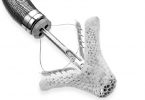Mary Lou Valenta wasn’t sure what was causing her leg pain. Other health issues, including diabetes and high blood pressure, overshadowed the nagging problem —until it got worse. Like a vise gripping her ankles, she says, it would disrupt her daily activities.
Ms. Valenta couldn’t walk from her car through a parking lot without stopping every 10 to 20 feet to relieve the pain. Dancing at her son’s wedding hurt her legs as well. “Boy, did I pay for that!” she says.
When excruciating pain began to wake her at night, a doctor diagnosed her with restless leg syndrome and prescribed sleep medication. But it didn’t help.
A stealthy disease
Recurring fatigue, pain and heaviness in the leg muscles can signal a blood flow problem called peripheral artery disease, or PAD, says Adam Cloud, MD, board-certified vascular surgeon at UHS. PAD is caused primarily by atherosclerosis, a condition that can damage the blood vessels leading to the arms, legs, stomach and head.
It is often first noticed in the legs, where it causes discomfort or weakness during activities such as walking and climbing stairs.
Angioplasty Provides PAD Relief
UHS vascular surgeons perform angioplasty and stent placement to open vessels blocked by PAD, restoring blood flow and alleviating painful symptoms. These minimally invasive procedures are often performed using local anesthesia, and patients may go home the same day. Here’s what to expect on the day of surgery:
- Patients may be given medications to relax and to prevent blood clots.
- Local anesthesia is applied to numb the treatment area.
- While viewing the vein under X-ray, the surgeon guides a small catheter into the blocked blood vessel.
- Another catheter is guided in with a small balloon that is inflated when it reaches the blocked area, opening the vessel. The balloon and catheters are then withdrawn.
- If a stent is prescribed, the surgeon inserts it along with the balloon. The stent opens as the balloon expands. The stent remains after the balloon is withdrawn, helping to hold open the vessel indefinitely.
PAD is a common problem and age is a big risk factor. According to the U.S. Centers for Disease Control and Prevention, 12 to 20 percent of people in the U.S. who are older than age 60 have the disease. It often goes undiagnosed or misdiagnosed until it causes worsening symptoms, says Dr. Cloud.
“Many people needlessly tolerate symptoms when there may be a simple solution to the problem,” he explains. “Instead, they learn to avoid the activities that cause pain, and put off getting care. Over time, their condition worsens and surgical intervention may become necessary.”
That’s what happened to Ms. Valenta. It took a health emergency to find the cause of her pain.
Finding the culprit
At age 54, Ms. Valenta had a heart attack and underwent bypass surgery. At that time, a gangrenous wound was discovered on the bottom of her foot. Without good blood flow, the wound couldn’t heal, putting her at risk for a life- or limb-threatening infection.
Ms. Valenta was then diagnosed with PAD. UHS vascular surgeons performed an angioplasty procedure to open the blocked leg veins and stabilize her condition. The surgeons also performed an endarterectomy to clear plaque that had formed in her carotid arteries. This procedure can reduce the risk of stroke. Ms. Valenta says she felt immediate relief from the pain that had been plaguing her for years. With proper blood flow restored, she could focus on healing from her bypass surgery and from the foot wound.
SIMPLE TESTS HELP DIAGNOSE PAD
A vascular specialist can use non-invasive, in-office tests to diagnose PAD or rule it out. In some cases, imaging may be ordered to assess blood vessel damage and help determine the most effective treatment. Tests for PAD include:
- A physical exam
- A blood pressure test at the arm and ankle (ankle-brachial index, or ABI)
- Blood flow measurement using a handheld Doppler or ultrasound device
- Angiography, using CT or MRI and a contrast dye to view the blood vessels
After a year of recovery, Ms. Valenta’s leg pain began to return, and UHS vascular specialists recommended a more permanent solution. Small devices called stents were inserted into the problem vessels to keep them open.
The procedure changed her life, says Ms. Valenta. The leg pain hasn’t returned in the 11 years since. She is no longer kept awake at night and can once again enjoy her hobbies, including shopping at the mall. “I can walk quite a distance now with no pain,” she says.
Catch PAD early
A vascular specialist can often diagnose PAD using in-office, non-invasive diagnostic tests. If needed, CT or MRI imaging may also be used to view the blood vessels.
In its early stage, PAD may be managed with lifestyle changes and medication. In later stages, a vascular surgeon can open or clear blocked vessels to relieve symptoms and prevent damage to the leg or other affected areas of the body.
Treatment can prevent symptoms from becoming severe and even life-threatening, says Dr. Cloud. As in Ms. Valenta’s case, lack of blood flow to the limbs can lead to skin wounds and ulcers that don’t heal. Untreated PAD can eventually result in the loss of a leg and an increased risk of coronary artery disease, heart attack and stroke.
Ms. Valenta encourages others to get aches and pains checked out immediately rather than risk worsening health. She believes that better management of her blood pressure medication and quitting smoking earlier in life would have helped her avoid these health emergencies.
“Listen to your body, it’s trying to tell you something,” she advises. “People don’t realize the kind of help that is out there. One small procedure might save your life.”
IS IT PAD?
To schedule an appointment with Adam Cloud, MD, or another UHS vascular specialist, call 763-8100.







